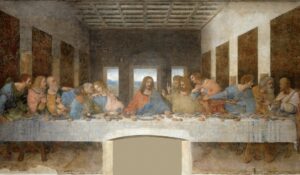
On Easter weekend, traditional folk music will be presented in the Fonó Buda Music House.Continue reading

On Maundy Thursday, Christians remember the Last Supper, the establishment of the Eucharist, and the sacrament of Holy Orders.
“In the mystery of Maundy Thursday, the most sublime love of the Eucharistic gift stands in contrast to the pain of betrayal,” states a press release from the Hungarian Catholic Bishops’ Conference sent to MTI.
The statement explains that in the morning of Maundy Thursday, a Chrism Mass is held in the bishop’s cathedrals. The bishop celebrates Mass with the priests of the diocese, who renew their vows made during ordination. During this Mass, the oils used in baptisms, confirmations, ordinations, church consecrations, and anointing of the sick are blessed.
In the evening, every church holds a Mass to commemorate the Last Supper, the institution of the Eucharist, and the sacrament of Holy Orders.
At the beginning of the evening Mass, the symbols evoke the joy of the Last Supper. The priest wears a white chasuble, the organ plays, and flowers adorn the altar. During the Gloria, bells, chimes, and the organ sound in every church, only to fall silent until Holy Saturday evening, with the sound of clappers instead, marking deep mourning. The bells “go to Rome” during this time, and “signs of sadness and pain appear.”

Leonardo da Vinci: The Last Supper; Photo: Wikipedia
In the Gospel reading for Maundy Thursday, the story is told of how Jesus washed his disciples’ feet. His act is “an eternal example” of how to serve one another “with a humble heart.” Therefore, as part of the Holy Thursday service, the bishop or priest washes the feet of chosen individuals.
At the end of the Mass, the Eucharist is taken to the side altar. This is followed by the stripping of the altar, when all decorations are removed. These actions symbolize Jesus’ arrest and captivity.
The Mass ends in silence, without a final blessing, symbolizing the pain shared in Jesus’ suffering.
Maundy Thursday is one of the oldest feasts of the Church. In the early Church, on this day, penitents were welcomed back.
On the same day Pope Francis called on the Church and humanity to choose a side in a world filled with fear and injustice, during his homily at the Chrism Mass held at St. Peter’s Basilica. In his traditional address to the clergy, he emphasized that a choice must be made in response to the wounds caused by the created world and the denial of brotherhood among people.
“Many fears can dwell within us and terrible injustices surround us, but a new world has already been born,”
the Pope referenced the message of the Resurrection. The Pope urged his fellow priests to carry the message of joy to the poor, freedom to the prisoners, sight to the blind, and liberty to the oppressed.
Instead of bitterness, Pope Francis advocated for the just distribution of the world’s resources and the cancellation of countries’ debts.
Many fears can dwell within us and terrible injustices surround us, but a new world has already been born. God so loved the world that he gave us his Son, Jesus. He pours balm upon our wounds and wipes away our tears. #HolyThursday https://t.co/jEEfEXchiX
— Pope Francis (@Pontifex) April 17, 2025
The usual Chrism Mass on Maundy Thursday morning was led by Cardinal Domenico Calcagno, the retired president of the Apostolic See’s Administration (APSA). 1,800 priests were present at the Basilica, including more than 80 cardinals and bishops. They consecrated the holy oils used in the sacraments: the chrism used in confirmation, and the oils for baptism and anointing of the sick. The priests of the Roman diocese renewed their priestly vows.
In the afternoon, the foot-washing ritual is observed in memory of the Last Supper. The Vatican has not confirmed a report, based on Vatican sources, that Pope Francis plans to visit the nearby Regina Coeli prison to meet with prisoners. The Vatican emphasized that the Pope’s program will be adjusted in view of his health.
Unlike his predecessors, Pope Francis does not wash the feet of his fellow priests but has chosen different locations to visit each year since his election, with the exception of the pandemic period.
Over the past twelve years, Pope Francis has visited hospitals, nursing homes, migrant centers, and most frequently prisons on Maundy Thursday. On December 26 last year, at the beginning of the Jubilee Year, Pope Francis opened the Holy Door at the Rebibbia prison.
During Easter, security measures are heightened in Rome, which is filled with tourists and pilgrims: increased checks have been implemented at airports, train stations, and major religious and tourist sites.
Via MTI, Featured picture: MTI/Czeglédi Zsolt